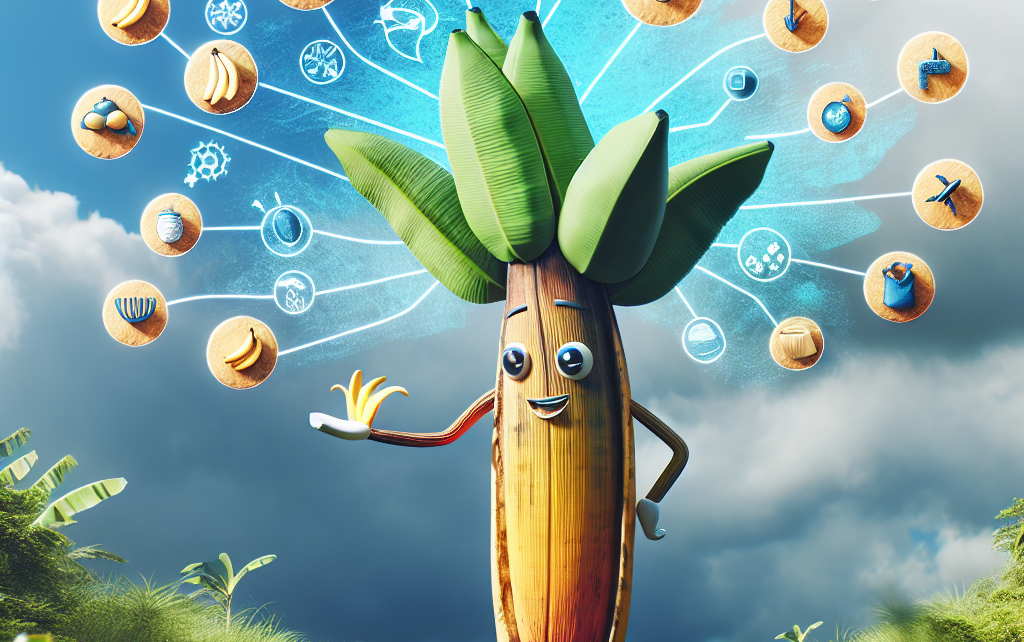As a nutritionist with a deep appreciation for the wonders of bananas, I am delighted to take you on a journey into the realm of banana plants. In this detailed exploration, we will unravel the mysteries surrounding banana plants, from their unique characteristics to tips on cultivation. Let’s dive into the fascinating world of banana plants and discover the secrets that make them a cherished addition to gardens and indoor spaces alike.

Understanding Banana Plants
Anatomy of a Banana Plant
A typical banana plant comprises several components, each playing a crucial role in its growth and development. Here’s a breakdown of the key parts:
Pseudo stem:
The pseudo stem, often mistaken for the trunk, is a tightly packed arrangement of leaf bases. It provides structural support to the plant.
Leaves:
Banana plants have large, elongated leaves with a distinct midrib. These leaves contribute to the plant’s ability to capture sunlight for photosynthesis.
Rhizome:
The rhizome is the underground stem from which roots emerge. It anchors the plant and facilitates nutrient absorption.
Inflorescence:
The inflorescence, known as the banana heart or bud, eventually gives rise to clusters of bananas. It emerges from the center of the pseudostem.
Roots:
The roots of a banana plant play a vital role in nutrient uptake from the soil. They form a network around the rhizome.
Varieties of Banana Plants
Banana plants come in various varieties, each with its unique characteristics. Here are some popular types:
Dwarf Banana Plant:
Ideal for smaller spaces, the dwarf banana plant (Musa spp.) is compact and well-suited for container gardening.
Red Banana Plant:
Characterized by its reddish-purple skin and sweet flavor, the red banana plant adds a colorful touch to gardens.
Blue Java Banana Plant:
Also known as the “ice cream banana,” the Blue Java variety is prized for its sweet, creamy taste and a distinctive silvery-blue peel.
Variegated Banana Plant:
Featuring leaves with unique patterns, variegated banana plants add an ornamental appeal to gardens.
Cultivating Banana Plants
Planting:
When planting banana trees, choose a sunny location with well-draining soil. Space the plants appropriately to allow for optimal growth.
Watering:
Banana plants require consistent moisture. Water deeply but allow the soil to dry out slightly between watering sessions.
Fertilization:
Use a balanced fertilizer to provide essential nutrients. Applying compost or well-rotted manure can also enhance soil fertility.
Protection from Cold:
While some banana varieties are hardy, others may need protection from frost. Consider mulching around the base during colder months.
Utilizing Banana Plants for Gardening
Banana Water for Plants
One interesting aspect of banana plants is their potential benefit to other plants through banana water. This nutrient-rich water can be obtained by soaking banana peels in water and using the infused liquid for watering.
Steps to Make Banana Water for Plants
Step Procedure
1 Collect banana peels.
2 Chop peels into small pieces.
3 Place peels in a container.
4 Add water and let it soak for a few days.
5 Dilute the banana water before using.
Banana Peel Water for Plants
Banana peels can be directly utilized to create a nutrient-rich water solution for plants.
Steps to Make Banana Peel Water for Plants
Step Procedure
1 Collect banana peels.
2 Blend peels with water to create a liquid.
3 Strain the liquid to remove solid particles.
4 Dilute the solution with water.
5 Use the banana peel water to water plants.
String of Bananas Plant
The string of bananas plant (Senecio radicans) is a unique succulent with trailing vines that resemble a cascade of bananas. It’s a popular choice for indoor gardens and hanging baskets.
String of Bananas Plant Care Tips
Care Aspect Recommendation
Sunlight Bright, indirect sunlight.
Watering Allow soil to dry between watering.
Soil Type Well-draining cactus mix.
Temperature Average room temperature.
Pruning Trim leggy stems for a compact appearance.
FAQ Section
Q1: Can I Grow Banana Plants Indoors?
A1: Yes, banana plants can be grown indoors, especially dwarf varieties. Ensure they receive sufficient sunlight and use well-draining soil.
Q2: Are Banana Peels Good for Plants?
A2: Yes, banana peels are rich in nutrients like potassium and can be used as fertilizer. Whether in water or composted, they contribute to soil health.
Q3: How Do I Care for a Red Banana Plant?
A3: Red banana plants require similar care to other varieties. Provide sunlight, well-draining soil, and protection from frost if necessary.
Q4: Can Banana Water Benefit Tomato Plants?
A4: Yes, banana water is beneficial for tomato plants. The nutrients in banana water can enhance soil fertility.
Q5: Is There a Difference Between Eating Banana & Drinking Banana?
A5: While you can certainly enjoy the delightful taste of a banana by eating it, “drinking” a banana typically refers to incorporating it into smoothies or infusing its nutrients into water for plant care.
Conclusion
Banana plants are not only a source of delicious fruit but also fascinating additions to gardens and indoor spaces. From cultivating different varieties to exploring creative ways to use banana water for plants, the possibilities are vast. Whether you’re a seasoned gardener or a beginner, the joy of growing banana plants lies in the journey of nurturing these remarkable botanical wonders.
As you embark on your banana plant adventure, remember to tailor care routines based on the specific variety you choose. Whether it’s the whimsical string of bananas plant or the classic red banana tree, may your banana-growing experience be fruitful and enjoyable. Read Our Other Articles Also.




